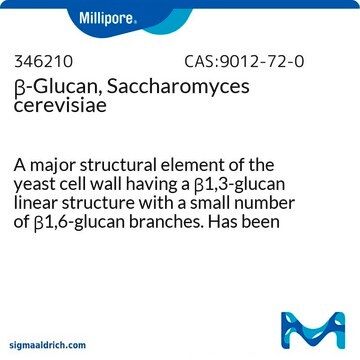67138
β-(1→3)-D-Glucanase from Helix pomatia
≥0.2 U/mg
Sign Into View Organizational & Contract Pricing
All Photos(1)
About This Item
Recommended Products
biological source
Helix pomatia
Quality Level
form
powder
specific activity
≥0.2 U/mg
storage temp.
−20°C
Looking for similar products? Visit Product Comparison Guide
Application
β-(1→3)-D-Glucanase from is used to digest β -1,3-glucan, which is a major component of cell walls. β-(1→3)-D-Glucanase from Helix pomatia has been used fto digest the cell walls of C. albicans .
Biochem/physiol Actions
Deletion of the C.albicans histidine kinase gene (CHK1) improves recognition by phagocytes through an increased exposure of cell wall b-1,3-glucans, which are readily digested by β-(1→3)-D-Glucanases .
Packaging
Bottomless glass bottle. Contents are inside inserted fused cone.
Unit Definition
One unit corresponds to the amount of enzyme which liberates 1 μmol of glucose from laminarin (Cat. No. 61340) per minute at pH 5.0 and 37 °C
Signal Word
Danger
Hazard Statements
Precautionary Statements
Hazard Classifications
Resp. Sens. 1
Storage Class Code
11 - Combustible Solids
WGK
WGK 1
Flash Point(F)
Not applicable
Flash Point(C)
Not applicable
Choose from one of the most recent versions:
Already Own This Product?
Find documentation for the products that you have recently purchased in the Document Library.
Customers Also Viewed
Enrico Ragni et al.
Fungal genetics and biology : FG & B, 48(8), 793-805 (2011-05-24)
Cell wall biogenesis is a dynamic process relying on the coordinated activity of several extracellular enzymes. PHR1 is a pH-regulated gene of Candida albicans encoding a glycosylphosphatidylinositol-anchored β(1,3)-glucanosyltransferase of family GH72 which acts as a cell wall remodelling enzyme and
The RabGAP proteins Gyp5p and Gyl1p recruit the BAR domain protein Rvs167p for polarized exocytosis.
Magali Prigent et al.
Traffic (Copenhagen, Denmark), 12(8), 1084-1097 (2011-05-11)
The Rab GTPase-activating proteins (GAP) Gyp5p and Gyl1p are involved in the control of polarized exocytosis at the small-bud stage in Saccharomyces cerevisiae. Both Gyp5p and Gyl1p interact with the N-Bin1/Amphiphysin/Rvs167 (BAR) domain protein Rvs167p, but the biological function of
N P Sachivkina et al.
Bulletin of experimental biology and medicine, 149(6), 727-730 (2010-12-18)
Lyticase (a bacterial enzyme) was tested as a new antimycotic drug. Of all objects studied, Cellulomonas cellulans AC-870 strain proved to be most productive for this enzyme. A technology for lyticase isolation and purification was proposed. An experimental model of
Tomonari Tamashiro et al.
Glycoconjugate journal, 29(1), 77-85 (2011-12-27)
A carbohydrate-binding module from family 13 (CBM13), appended to the catalytic domain of endo-1,3-β-glucanase from Cellulosimicrobium cellulans, was overexpressed in E. coli, and its interactions with β-glucans, laminarin and laminarioligosaccharides, were analyzed using surface plasmon resonance biosensor and isothermal titration
María de Medina-Redondo et al.
PloS one, 5(11), e14046-e14046 (2010-12-03)
The formation of the cell wall in Schizosaccharomyces pombe requires the coordinated activity of enzymes involved in the biosynthesis and modification of β-glucans. The β(1,3)-glucan synthase complex synthesizes linear β(1,3)-glucans, which remain unorganized until they are cross-linked to other β(1,3)-glucans
Our team of scientists has experience in all areas of research including Life Science, Material Science, Chemical Synthesis, Chromatography, Analytical and many others.
Contact Technical Service










